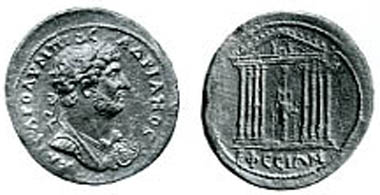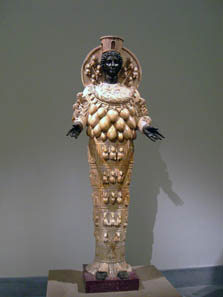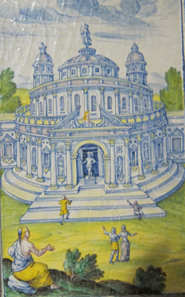Excitement was going about in the city of Ephesus. A silver smith called Demetrius wandered round the city. He earned his living with the production of small images of the altar of the great Artemis of Ephesus. Mainly because he felt himself being at risk of losing his own basis of existence, he poisoned his fellow citizens’ mind against a certain Paul whose talk of a sole god questioned the basis of existence of the city: the importance of the sanctuary.
And Demetrius was successful. A crowd of people joined him on his impromptu protest march to the theatre. The masses chorused “Great is Artemis of Ephesus” for hours, and Paul considered himself lucky that the furious mob didn’t lynch him.
The Act of the Apostles sometimes is an impressive witness of ancient self-conception. This short and liberally recounted story is indicative of the important role the cult of Artemis played in the life of the Ephesians. They considered it not only an important economic factor but an element of municipal pride as well. Thus, the famous temple was a popular subject on the civic coins.
Ephesos, Hadrian, 117-138. Medallion. Rev.: Temple of Artemis Ephesia with cult statue. BMC 77, 224. From auction Münzen und Medaillen AG, Basel 81 (1995), no. 494.
This is a very well preserved illustration. One can see many details of the temple’s design. The illustration shows the temple that was erected in the middle of the 4th cent. He was located in the very place where Artemis was worshipped as early as the 8th/7th centuries. The front – as on our coin – was decorated with eight columns whose upper and lower parts exhibited friezes. By a look at the lower part of the columns on the coin it becomes evident that the die cutter made an effort to display these ornaments. A free space between the columns provides the viewer with a glimpse into in the interior: he sees the statue of Artemis of Ephesus. Of course, the cult statue didn’t actually stand in the entry area of the temple. It wasn’t possible to have a look at it for it stood in the inner temple area. Since a coin doesn’t intend to give an accurate account of the design of the temple of Artemis but rather to lay a stress on its uniqueness, the die cutter made use of the method to bring the inner out.
Artemis of Ephesus. Roman copy with supplemented head and hands. Naples National Archaeological Museum. Foto: UK.
The artist depicted the features of the well-known Archaic cult image meticulously. Artemis wears a high head-gear, the so-called polos; at the very top one can see a mural crown like the ones known from city goddesses in Asia Minor. At the lower end of the head decoration veils are attached that fall onto the shoulders of Artemis on both sides. A simple line across her chest indicates the jewellery she wears around her neck, which in fact was rather elaborate, containing several circles. Below that, barely visible on the coin, the ‘breasts’ of Artemis are situated. There is any number of hypotheses on the meaning of this iconographic feature of Artemis’, ranging from the identification of these objects with eggs (either usual ones, either of an ostrich or of bees), grapes, buts, acorns, amulets as parts of a chest decoration, artificial breasts for cultic purposes, misinterpreted metal buckles of a chest armor, dates, material of a meteorite, magical flames and, last but not least, testicles of bulls.
The trickiest part for the die cutter was to depict Artemis’ arms: they were outstretched forwards, but that posture the artist simply couldn’t depict on the coin. So he folds them out sideways into the field. Below the ankles we see small birds attached to armlets. Long woolen fillets hang from the arms. The representations of Artemis never look alike. That may well be due to the fact that the entire decoration was removable. From many other contexts we are familiar with the habit of dressing cult statues properly, according to a variety of occasions.
In the tympanum, the triangular pediment above the portico, another detail can be viewed. In the middle, framed by two Nikes holding wreaths, a small door is depicted. Two further figures, reclining, are situated to the left and the right hand side. Pliny, NH 14.1.9 provides us with a small hint as to the function of this gate. He reports that in Ephesus there was a stairway leading from the ground to openings in the tympanum. Thus, it must have been important to provide the opportunity for someone to get from the interior of the temple up to the attic and to show himself in the window. Actually, we know of epiphanies of great Artemis. The door in the tympanum made it possible for a female priest of Artemis to appear to the marveling crowd, clad in the deity’s garments – just like today the pope today issues the blessing ‘urbi et orbi’ to the people waiting on St. Peter’s Square.
Artemis of Ephesus was an essential element of the lives of the citizens of Ephesus. Thanks to her protection they felt assured of their city being safe and secure. The celebrations in her honor constituted the much-anticipated festive highlight in municipal life. The pilgrims coming to Artemis to ask for her help left their money in the city – as did the tourists who had traveled to Ephesus to visit the temple. It comes as no surprise, then, that a guileless itinerant preacher like Paul put the Ephesians in such a flurry.
Nobody forgot about the temple: Here is a baroque version from a tiled stove. Winterthur, 1682. Historisches Museum Basel. Inv. 1895.13. Photo: UK.
In 1863, the Englishman J. T. Wood embarked to find the famous temple of Artemis of Ephesus. Nothing was left to see of this important building that was one of the Seven Wonders of the Ancient World. It took six whole years until the excavator, on the evening of New Year’s Eve 1896, in a test pit unearthed the marble foundation of the lost temple. Every archaeological remains of the Artemision on the surface had been gone due to the rise of the ground-water. Today, after year-long excavations, that had been interrupted and resumed several times, the disappointed traveler merely looks at a desert of stones which bear no witness anymore of the former importance of Artemis of the Ephesians.








